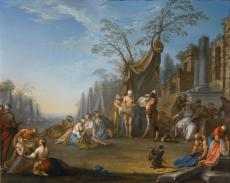


The Le Clercs formed a great dynasty of artists, beginning with the draughtsman and engraver Sébastien I Le Clerc (Metz, 1637 – Paris, 1714); continuing with his sons, the painter and ancien professeur at the Académie Royale de Peinture et de Sculpture, Sébastien II Le Clerc (Paris, 1676 – Paris, 1763), and Louis-Auguste Le Clerc (Paris, 1688 – Copenhagen, 1771); and ending with the former’s son, another painter, Jacques-Sébastien III Le Clerc (Paris, 1734 – Paris, 1785).
About the careers and productions of those of the first two generations, there is little doubt. Louis-Auguste is recorded as having trained as a sculptor and having won a second prize in 1712 at the Académie Royale. By 1731 he was working as an ornamental sculptor in Ansbach, and in 1735 his brother recommended him as an ornamental sculptor to Christian VI of Denmark, to work on Christiansborg Palace. There he remained, becoming a professeur at the Academy from its foundation in 1754 until his death. The artist of the third generation, Jacques-Sébastien III, is the one whose name is given to a number of paintings, often on wood or copper, variously of fêtes galantes, of mythological subjects providing an excuse for depicting female semi-nudity, and of a pair of twosided paintings on copper, with an innocent scene on one side, and a lewd play on its theme on the other. A few of these are initialled L. C., and a handful are dated. It is with the dates that problems begin to arise. One of a pair of very accomplished fête galante subjects that were auctioned in 2009 and again in 2010 is initialled L. C., with the date 1751. Jacques-Sébastien would then only have been in his 17th year. Had he been capable of such precocity, one would expect him to have made more of a noise in the world thereafter. Another painting, on panel, of women reclining in a landscape, with another standing and holding a basket of flowers is initialled L. C., with the date 1775 (i.e. four years after Louis-Auguste’s death).
The difficulty with identifying the artist of the pair of paintings dated 1751 with Jacques-Sébastien III does not end there. An artist recently identified as ‘M. Leclerc’ or ‘M. Le Clerc – ancien professeur’ exhibited a number of paintings, on panel, canvas and copper, of precisely the kinds of subject customarily attributed to Jacques-Sébastien III, at the Académie de Saint-Luc’s intermittent exhibitions, in 1752, 1753 and 1756.
Jacques-Sébastien III could not possibly have been called an ancien professeur in his 18th to his 22nd year. Nor could this have been his father, who, as a member of the Académie Royale de Peinture et de Sculpture, was precluded from exhibiting at the Académie de Saint-Luc, which was more of a craft guild, whose abolition the Académie Royale finally succeeded in obtaining. The answer can only be that this was Louis-Auguste, and that he was making occasional returns from Copenhagen to Paris, being able to paint as well as sculpt. Some support is lent to the idea of such returns by the fact that in the livret of the 1756 exhibition, his address is given as ‘Rue de Grenelle S. Honoré, chez un Sellier’: in other words, he had no abode of his own in Paris, but was lodging with a saddler.
The conclusion to be drawn from all this is that Louis-Auguste and his nephew Jacques-Sébastien III practised the same types and style of painting (further study may make it possible to distinguish between the two hands), into which the uncle would appear to have initiated his nephew. It is also worth pointing out that it was Louis-Auguste – but not apparently his nephew – who was born at the Gobelins, where his father had been given lodgings by virtue of having been appointed dessinateur et graveur du Roi, so that the sobriquet ‘des Gobelins’ may originally have been attached to his name, rather than to his nephew’s.
The present picture is not the first ‘orientalist’ painting by the Le Clercs to come to light, and its handling and, above all, the womenfolk in it are entirely those of their fêtes galantes and mythologies. What may originally have been the pendant to it, also on copper, and measuring 51.5 x 64.5 cm, was auctioned in 1999. Called La Visite du Sultan, Turquerie, it shows the visit of a pasha to the – clothed – women of his harem. It does not appear to have been signed, but was ascribed to ‘Sébastien-Jacques Leclerc, dit Leclerc des Gobelins’.
The Le Clercs were a large dynasty of French artists. Louis-Auguste trained as a sculptor and also painted.From 1735, he was a court sculptor to Christian VI of Denmark. He remained in Copenhagen, as professor atthe Royal Danish Academy of Fine Arts, until his death. As he and his nephew, Jacques-Sébastien III, paintedsimilar themes in a comparable style, it can be difficult to distinguish their work. The younger Le Clerc is knownfor his mythological subjects in pastoral settings.